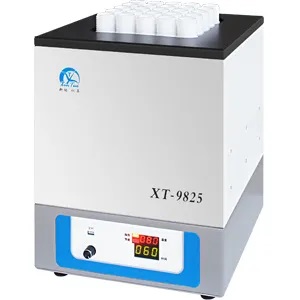
Marine pollution has become a global concern. How can technology be utilized to better ensure the safety of food and aquatic products?
This article takes the "ginseng in water" — eel as an example. Referring to GB 5009.268 National Food Safety Standard Determination of Multiple Elements in Foods, microwave digestion is used for the pretreatment of eels. This process can completely digest the sample, resulting in a clear and transparent digestion solution, facilitating the detection of metal content in eels to ensure their safety, applicable to many metals such as boron, sodium, magnesium, aluminum, potassium, calcium, vanadium, chromium, manganese, iron, cobalt, nickel, copper, zinc, and more.
Sample pretreatment heating instrument: XT 9825
Microwave digestion instrument: XT 9930

Sample pretreatment heating instrument

Microwave digestion instrument
Nitric acid and hydrogen peroxide are both of analytical grade (National Medicines Chemical Reagent Co., Ltd.)
Ultrapure water prepared by a water purification machine (i-Pure PRO2)
Approximately 0.8g of ground eel (accurate to 0.001 g) is taken in a high-throughput edition digestion tank, with 5mL HNO3 and 1mL hydrogen peroxide added.
Tighten the lid and place the digestion tank in the microwave digestion instrument, select the high-throughput mode, and carry out the digestion.
After cooling, take out the digestion tank, then place it in XT 9825 and drive off the acid at 100°C for 30 minutes. Use water to bring to volume.
After dilution, it was observed that the sample was completely digested, and the solution was clear without sediment.


Figure 4 Eel digestion results
The liquid volume inside the digestion tank should not be less than 5mL.
The digestion tanks should be acid-soaked, washed, and dried before use to remove background interference.
Avoid sample sticking to the sides when weighing. If it sticks, wash it down.
If the reaction is violent after adding acid, let it sit for a while until the reaction subsides before proceeding to the next step.
If the sample spills out of the digestion tank during predigestion, reweigh the sample for digestion.
If the sample reacts violently during pre-digestion, 1ml of water can be added.
When loading the digestion tanks, start from the outer ring and place them symmetrically.
The test sample was eel, with a sample size of 0.5g-1g; nitric acid and hydrogen peroxide were used for digestion, with the maximum experimental temperature being 190°C, and the sample was completely digested, with the digestion solution clear and transparent.
Using the XT-9930 sealed smart microwave digestion instrument: 42 samples can be digested simultaneously, achieving a high sample throughput; the entire digestion process takes about 1 hour, improving work efficiency. The samples were completely digested, and the digestion effect was ideal.